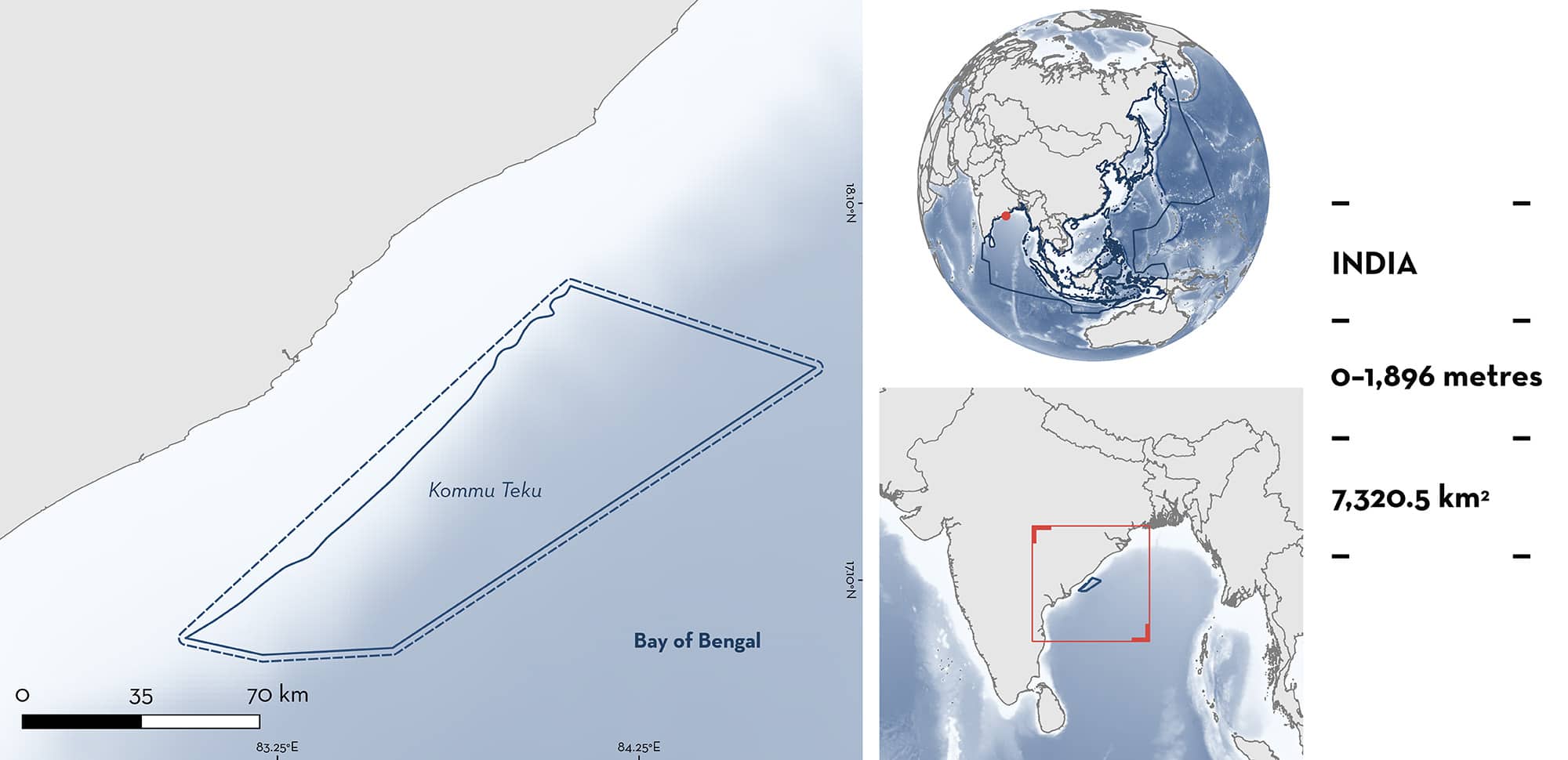ISRA FACTSHEETS
ISRA FACTSHEETS
ASIA REGION
Kommu Teku
Summary
Kommu Teku is situated off the northern coast of Andhra Pradesh, along the east coast of India. The area covers epipelagic, mesopelagic, and bathypelagic waters offshore of the continental shelf edge. Throughout most of the year, oceanography in this area is driven by the East Indian Coastal Current with surface currents moving northwards adjacent to the coastline. Within this area there are: threatened species (e.g., Spinetail Devil Ray Mobula mobular); and undefined aggregations (e.g., Sicklefin Devil Ray Mobula tarapacana).
Download factsheet
Kommu Teku
DESCRIPTION OF HABITAT
Kommu Teku is situated off the northern coast of Andhra Pradesh State, along the east coast of India. It ranges from off Burjupadu in the north to off Kakinada in the south. The area covers epipelagic, mesopelagic, and bathypelagic waters offshore of the continental shelf edge. The seafloor underlying the area is punctuated by features such as slopes and fans.
The mean annual sea surface temperature in the area ranges from 28°C to 32°C. Throughout most of the year, the region is impacted by the East Indian Coastal Current with surface currents moving northwards adjacent to the coastline (Hacker et al. 1998; Pirro et al. 2020).
This Important Shark and Ray Area is pelagic and is delineated from surface waters (0 m) to 1,896 m based on the bathymetry of the area and on the global depth range of Qualifying Species.
CRITERION A
VULNERABILITY
Two Qualifying Species considered threatened with extinction according to the IUCN Red List of Threatened Species regularly occur in the area. These are the Endangered Spinetail Devil Ray (Marshall et al. 2022a) and Sicklefin Devil Ray (Marshall et al. 2022b).
CRITERION C
SUB-CRITERION C5 – UNDEFINED AGGREGATIONS
Kommu Teku is an important area for undefined aggregations of two ray species.
Between 2020–2023, landing surveys (Payyat et al. unpubl. data 2023) and interviews with fishers at Kakinada (Karnad et al. unpubl. data 2021; Banerjee et al. unpubl. data 2023) indicated that Spinetail Devil Ray and Sicklefin Devil Ray are sighted year-round in aggregations across years within the area. These species are primarily caught as the incidental catch of tuna fisheries operating in the area and landed at Kakinada, the largest landing site for the tuna-driven fishery operating off the central eastern coast of India. Interviews with fishers (n = 113 in 2020 and 2021, Karnad et al. unpubl. data 2021; n = 26 in 2023, Payyat et al. unpubl. data 2023) indicate that this is the only known area where these devil ray species regularly co-occur in considerable numbers, despite there being tuna fisheries practiced across other parts of the east coast of India. Fishers from other key sites along India’s east coast (West Bengal, Visakhapatnam, and Chennai) report far smaller numbers of devil rays than vessels operating off Kakinada. This indicates that the area therefore hosts larger devil ray numbers than other parts of the Bay of Bengal, for yet unknown reasons. Landing surveys have recorded 334 Spinetail Devil Rays and 163 Sicklefin Devil Ray from the area (Payyat et al. unpubl. data 2023). For Spinetail Devil Ray, this has included six instances of five or more individuals landed on a single day, and for Sicklefin Devil Ray, this has included four instances of five or more individuals landed on a single day (Payyat et al. unpubl. data 2023). Further information is required to understand the nature and function of these aggregations.
Download factsheet
SUBMIT A REQUEST
ISRA SPATIAL LAYER REQUEST
To make a request to download the ISRA Layer in either a GIS compatible Shapefile (.shp) or Google Earth compatible Keyhole Markup Language Zipped file (.kmz) please complete the following form. We will review your request and send the download details to you. We will endeavor to send you the requested files as soon as we can. However, please note that this is not an automated process, and before requests are responded to, they undergo internal review and authorization. As such, requests normally take 5–10 working days to process.
Should you have questions about the data or process, please do not hesitate to contact us.


